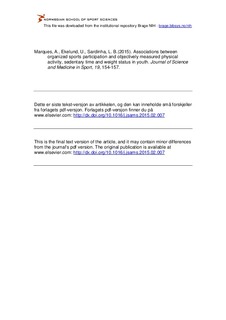| dc.contributor.author | Marques, Adilson | |
| dc.contributor.author | Ekelund, Ulf | |
| dc.contributor.author | Sardinha, Luis B. | |
| dc.date.accessioned | 2018-04-30T11:46:14Z | |
| dc.date.available | 2018-04-30T11:46:14Z | |
| dc.date.created | 2016-01-07T12:58:04Z | |
| dc.date.issued | 2016 | |
| dc.identifier.citation | Journal of Science and Medicine in Sport. 2016, 19, 154-157. | nb_NO |
| dc.identifier.issn | 1440-2440 | |
| dc.identifier.uri | http://hdl.handle.net/11250/2496541 | |
| dc.description | I Brage finner du siste tekst-versjon av artikkelen, og den kan inneholde ubetydelige forskjeller fra forlagets pdf-versjon. Forlagets pdf-versjon finner du på sciencedirect.com / In Brage you'll find the final text version of the article, and it may contain insignificant differences from the journal's pdf version. The definitive version is available at sciencedirect.com | nb_NO |
| dc.description.abstract | Objectives: The purpose of this study was to examine whether participation in organized sports is related to achieving physical activity recommendations, body mass index (BMI), objectively measured PA intensity and time spent sedentary. Design: Cross-sectional study. Methods: The sample comprised 973 children and adolescents (427 boys, 546 girls) aged 10-18 years (Mage=14.1±2.4). Organized sport was self-reported. Physical activity and time spent in moderate and vigorous intensity PA (MVPA) and sedentary time was assessed with accelerometers. Results: More boys (51.3%) than girls (28.3%) reported to be involved in organized sports participation (p<0.001). Those who were engaged in organized sports were more likely to achieve physical activity guidelines (OR=1.64, 95% CI: 1.14-2.35, p<0.01), spent more time in MPA (OR=1.01, 95% CI: 1.01-1.02, p<0.01), VPA (OR=1.09, 95% CI: 1.05-1.13, p<0.001), and MVPA (OR=1.01, 95% CI: 1.01-1.02, p<0.001) than those who did not participate in organized sports. No associations between organised sport participation and time spent sedentary or BMI was observed. Conclusions: Engagement in organized sports is related to higher levels of objectively measured MPA, VPA and achieving the recommended levels of MVPA in youth; however participation in sports appears unrelated to time spent sedentary and BMI. Our results suggest that promoting organised sport may increase physical activity of at least moderate intensity in young people. | nb_NO |
| dc.language.iso | eng | nb_NO |
| dc.subject | accelerometer | nb_NO |
| dc.subject | sport | nb_NO |
| dc.subject | BMI | nb_NO |
| dc.subject | Portugal | nb_NO |
| dc.subject | cross-sectional | nb_NO |
| dc.title | Associations between organized sports participation and objectively measured physical activity, sedentary time and weight status in youth | nb_NO |
| dc.type | Journal article | nb_NO |
| dc.type | Peer reviewed | nb_NO |
| dc.description.version | acceptedVersion | nb_NO |
| dc.source.pagenumber | 154-157 | nb_NO |
| dc.source.volume | 19 | nb_NO |
| dc.source.journal | Journal of Science and Medicine in Sport | nb_NO |
| dc.source.issue | 2 | nb_NO |
| dc.identifier.doi | 10.1016/j.jsams.2015.02.007 | |
| dc.identifier.cristin | 1307795 | |
| dc.description.localcode | Seksjon for idrettsmedisinske fag / Department of Sport Medicine | nb_NO |
| cristin.unitcode | 150,34,0,0 | |
| cristin.unitname | Seksjon for idrettsmedisinske fag | |
| cristin.ispublished | true | |
| cristin.fulltext | postprint | |
| cristin.qualitycode | 1 | |
